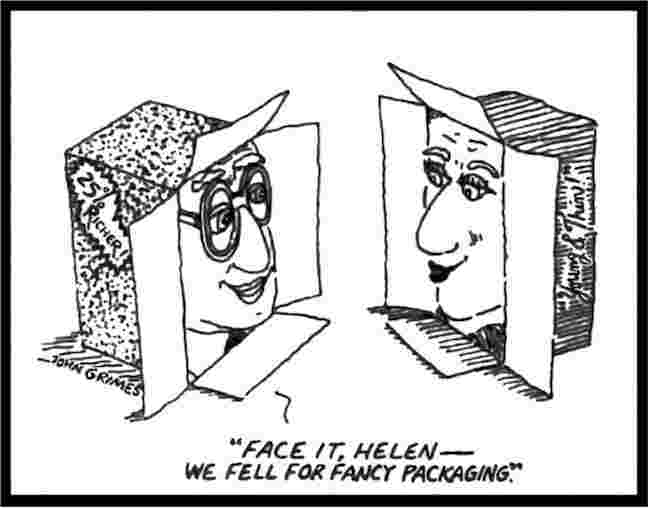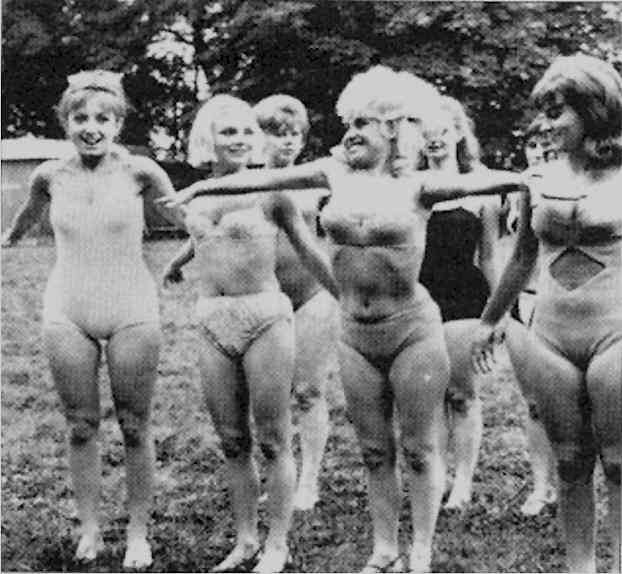Fool Thyself
Self-DeceptionSuppose we were able to share meanings freely without a compulsive urge to impose our view - David Bohm It is the nature of ambition to make men liars and cheats, to hide the truth in their breasts, - Kenneth Tynan
Source: Funny Times, probably 1997 funnytimes.com
Lies We Live By: The Art of Self Deceptionby Eduardo Giannetti, Bloomsbury, 304 pages; $24.95 and £15.99 "Every day, every day, things get better in every way." The French know it as la méthode Coué, after an early 20th-century quack who touted the curative value of autosuggestion. Dale Carnegie, the American fountainhead of the modem self-help manual, called it the power of positive thinking. Fooling yourself into feeling better about life is easy to deride. But, if believing false things about yourself makes you happier, is such self-deception always wrong? Is exaggerating your talents and prospects so bad if avoiding negative thoughts helps you lead a more active and satisfying life? From Socrates on, most western philosophers and moralists have taken a hard line on this matter. Under the bracing slogan "Know thyself' (which Montaigne, for one, had carved on his ceiling), they have tended to treat self-deception as a regrettable, if intriguing, weakness. lt is a sign of the power of self-deception that there is so little obvious evidence of its power. The phenomenon Is simultaneously elusive and widespread, as Eduardo Giannetti, a Brazilian historian of ideas, observes in this series of short ruminations. The more you insist you are free from it, the likelier it is that you are a victim. And this is not the only way in which self-deception is odd. There seems to be something strange in the very idea of deceiving yourself. Who is fooling whom? How can you lie and not know you are lying? Self-knowledge sounds more straightforward. But there is a haziness, too, about what that involves. Self-knowledge might be narrowly taken to consist in a Freudian grasp of the childhood sources of your motivations. Or it could be understood extravagantly as a thorough grasp of reality and man's place therein. A further point is that people without self-knowledge tend not just to believe false things about their own merits. They subscribe to religious and political views which shore up these beliefs. Most religions have taught that those who adhere to them have a privileged place in the universe. Secular ideologies such as Marxism hold to much the same view. There is, in addition, something unrealistic in the very ideal of self-knowledge. Aren't self-deception and its close cousin, self-love, too ingrained - and too useful - to be dispensed with? At times Mr Giannetti writes as if caring less about strangers than about yourself, your friends and your family was a form of self-deception, a sliding away from the impartiality essential to truth. But this is surely a confusion: you may care about them simply because they are yours, without falsely believing that they have special value in themselves. By nature, people are soft on themselves. Everyone is inclined to think they and the things they care about are undervalued. People are partial in assessments of political programs or religious creeds and rarely judge themselves by the standards they apply to others. Nor, arguably, should self-deception be eradicated, even if it could be. As Mr Giannetti acknowledges, it brings benefits, or certainly seems to. It gives the confidence to persevere in life: many successful people are motivated, in their early years, by an irrational faith in themselves. Against the philosophical grain, Pascal pursued a similar line, holding that evidence and truth were far from sacrosanct when it came to beliefs. Happiness, he argued, lay in self-deception, the truth about our corrupt, mortal natures being too horrible to contemplate. Pascal meant this as a caution against too much high-mindedness. And yet, facts do matter; the ideal of self-knowledge remains powerful and attractive. It has inspired many profound and moving works of art. Augustine's and Rousseau's "Confessions", Montaigne's "Essays" and Rembrandt's self-portraits all aimed to present their creators as they really were, or stripped at least of the conceits and illusions with which most of us protect ourselves. One useful thought, which Mr Giannetti does not really pursue, is that the very contrast between paralysing self-awareness and energising self-deceit may be overdrawn. In the end, might it not come down to temperament? Some people, after all, achieve plenty without an exaggerated appraisal of their talents, aware of life's limits but not dwelling on them at every bell. Though an erudite scholar, Mr Giannetti does not quite do justice to a rich and noble theme. He set out, admirably, to write a book that would appeal to the general reader as well as to his academic colleagues. But the result tends to be both showy and rather vacuous. Maybe he should have been harder on himself. Source: The Economist 13 May 2000 See also:
Bra Wars
British Humour New York - Pulleys, airbags, advanced plastic moulds and silicone-filled inserts. The modem brassiere, with as many as 43 components and a design as complicated as a suspension bridge, has long been a small miracle of engineering. Now it is trying to go high-tech. Growth in the bra industry has sagged since the mid-l990s, when Wonderbra and Ultrabra went chest-to-chest in the cleavage wars, and chains such as Knickerbox in Britain and Victoria's Secret in America moved lingerie out of the backrooms of department stores. Since 1997 Britain's £600m ($850m) bra market has grown by less than 2% a year, according to Mintel, a research firm; the $4.6 billion American market has not done much better. One of the latest attempts to support the market is the Bioform, now the hottest-selling bra in Britain. It was developed by Seymour Powell, the consultants behind the world's first cordless kettle. The Bioform replaces underwiring with a soft moulded core of plastic around a rigid ring - a design originally meant for the Frisbee. Also new to the market is the Ultimo, developed by a Scottish former model working with a group of German scientists. Sewn into the cups of this bra, a big hit at Saks Fifth Avenue in New York, are silicone-gel pads that mimic breast tissue, a safer alternative to implants. Meanwhile, Wonderbra, owned by America's Sara Lee, is putting its parent's ample resources behind a "variable cleavage" bra, equipped with pulleys to draw the breasts together. And Gossard, now also part of Sara Lee, will next spring launch the Airotic. Based on the principles of a car airbag - this could mean anything from "bag containing air" to "explosive inflation under violent deceleration" - it uses valves to provide lift. Plainly unsuitable for pneurotics. The market for bras that enhance the female form has to contend with at least one natural development: unaugmented breasts are getting bigger by themselves, thanks to the pill and changes in diet. The average cup size in Britain has grown from 34B to 36C over the past 30 years; half of all British women are now a D cup or bigger, which may explain why two-thirds of them complain that their bras do not fit properly. Smarter designers have spotted this untapped potential. Richard Seymour, the Bioform's developer, says his product, which starts at size 34C, is aimed specifically at big women who find normal, underwired bras painful. These innovators hope to see faster growth in the market. Others might regard it as a mixed blessing. Surging sales of bras are claimed to be an indicator of economic downturn: women cut back on big purchases in a recession, and buy new underwear to cheer themselves up. The Fed's chairman, Alan Greenspan, a great one for a shapely statistic, had better keep an eye out for a bounce in bra sales. Source: The Economist 2 December 2000
How Ladies Have Been Containing Themselves through the AgesWomen have used garments designed to lift, separate and restrain their breast since as early as 2500BC. Minoan women on the island of Crete wore bra-like garments that lifted the bare bust out of their clothing.
A Basic List of Bra DesignsAverage Figure Bra: Just what it sounds like. The average figure bra is generally worn by women with average figures, the B and C cup sizes. Source: ebrasetc.com
Wonderbra Recalls Bra after Cleavage Plunger PopsLondon - The creator of cleavage-making Wonderbra said it was recalling its latest invention after women complained their bras were snapping from the strain. The bra, called the "Deep Plunge Clearly Daring" and made for diving necklines, went on sale in Britain last month, but its makers said it had received complaints that the strap connecting the two cups had broken while being worn. The company Playtex, which like Wonderbra is also owned by Sara Lee Intimate Apparel, blamed the breakage on a "manufacturing fault" and said it only applied to a small number of products in an early production batch. The £22 (US$42, €32) brassiere would be back on the racks in January, the company said. But it means the design will likely miss out on making an appearance beneath open-bodiced blouses and dresses on show at racier holiday parties this season. Another Wonderbra designed for very revealing dresses, dubbed the "Deep Plunge Beyond Belief", was not affected by the recall, the company said. Wonderbra burst onto the scene in 1994 with eye-opening ads starring supermodel Eva Herzigova, promising extra lift and cleavage through a pushed-up and squeezed-in support system. Heralded as marking the come-back of the cleavage, Wonderbra has since lost some of the media fanfare but continues as a strong seller for Sara Lee. The US intimate apparel giant also has a hit with its pantyhose "Smooth Illusion", which promise to make the wearer's bottom appear five pounds (two kilograms) lighter. Source: story.news.yahoo.com AFP Monday 12 December 2004
For articles on affair motivators, changing relationships, do-it-yourself psychotherapy, lies, insincerity, social graces, cosmetic surgery, roots of culture, self-deception, love, and reunions of lost
relatives click the "Up" button below to take you to the Index page for this Relationships section. |
 Animals
Animals Animation
Animation Art of Playing Cards
Art of Playing Cards Drugs
Drugs Education
Education Environment
Environment Flying
Flying History
History Humour
Humour Immigration
Immigration Info/Tech
Info/Tech Intellectual/Entertaining
Intellectual/Entertaining Lifestyles
Lifestyles Men
Men Money/Politics/Law
Money/Politics/Law New Jersey
New Jersey Odds and Oddities
Odds and Oddities Older & Under
Older & Under Photography
Photography Prisons
Prisons Relationships
Relationships Science
Science Social/Cultural
Social/Cultural Terrorism
Terrorism Wellington
Wellington Working
Working Zero Return Investment
Zero Return Investment
